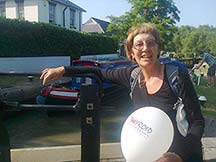|
 |
|
|
Laurence Housman Anniversary Walk: FAQs These are the questions that I've been asked most frequently. Hopefully, with the route map and clicking on pages for the day-by-day details, you will be able to find all the information you need - so that joining the sponsored walk is just right for you. See you soon! I can only join the sponsored walk for a few hours. What should I do? Work out which part of the route will best suit you (& your friends). See what date the walkers pass along there, ensuring both place and date are convenient. Then just turn up! If you're not familiar with the local footpaths, join at the start: 10 am each day unless indicated otherwise. This makes it easy to spot the walkers and join in. I can only do the walk for 1-2 miles, so what do I need to bring? Some snacks and, depending on the summer weather, a bottle of water plus sunblock. I'd like to join the walk for at least one day. What do I need to do? As well as the above suggestions, bring a packed lunch. It's worth carrying a light rucksack and, depending on the weather, waterproof jacket. As small sections of the route may still be muddy (given earlier flooding), you will probably be most comfortable in walking boots. Finally, a mobile phone & charger are invaluable. I'm not familiar with the places where we'll walk. What do you suggest? If you don't know the footpaths well it's advisable to join the walk at the starting point for that day. Additionally, it is extremely helpful to have the relevant OS map. The day-by-day pages note which OS map you need for that section, with the names of the footpaths we will be following, plus train stations etc. How is each day's walk organized? Start time: all walks depart at 10 am (any exceptions eg Bromsgrove, assemble at 10, depart 10.30) are noted on the day-by-day pages. Once we've reached where we join the walk, how do we get back again? Work out whether you will travel by train, bus or car to the join us. If you're driving, you'll need either a helpful friend, to return to your starting point by public transport. The advantage of reaching the walk by train or bus is you can return home direct from your finishing point. This is easy where there are towns nearby, less easy in remote countryside. On the day-by-day pages, stations are noted. It is now also possible to google (not just trains) rural bus routes. We have experienced real problems only in rural areas on Sundays. So how easy is it to find overnight accommodation near the route? It varies. It's easier in cities and towns, less easy in small villages. The day-by-day details provide suggestions & contact details of where I'm staying. As much of the route goes through popular towns (especially Stratford) or beautiful countryside (Cotswolds), you are strongly urged to make your booking as soon as you can. They get filled up quickly! Or do you have a friend or family who lives nearby? We're going to walk for a couple of days. What should we pack? As little as possible! Ensure your rucksack is light-weight. Weigh everything (at least in your mind) before you pack. In additional to the earlier suggestions, pack a toothbrush, tiny tube of toothpaste, spare pair of socks and t-shirt. As you'll also be carrying bottled water, keep food to a minimum: nuts are light but nutritious. So my tip is ~ go for full English breakfast before you set out. Then there's less to carry! Have you already tried out the whole route? Not all of it. But I walked the first 2-3 days' path (with Laurence's biographer, Elizabeth Oakley) which was really helpful. I've also walked the Wychwood Way and the Thames Path. The day-by-day pages indicate which sections have not been recce'd ~ luckily they all look fairly straightforward. Is there anything else we need to do? Please check these Housman Walk pages a few days before you set off. Inevitably, there may be minor amendments to route details. Any alterations will be clearly highlighted. So what's inspired this sponsored walk? In 2012 I attended a Housman Society weekend, and was entranced by the 'Dear Mrs Ashbee' performance given by Celia Jones & Pamela Marshall. Based on Laurence's witty letters to Janet Ashbee, it included those written on his 1903 tramp. This enticing vision of Laurence's long-distance walk caught my imagination. Then last July I did a 200-mile sponsored canal walk for British Thyroid Foundation (BTF), raising £3,500. After I got home, my feet kept itching to go walking again. I wondered if I could I retrace Laurence's 1903 route? So last October I visited Cambridge to consult the Ashbee papers, and was entranced by Laurence's elegantly gossipy letters to Janet Ashbee in Chipping Campden. Walking feels wonderfully relaxing and healthy. Last year, absolutely everyone who joined in or sponsored me for BTF really enjoyed themselves. Long-distance walking is addictive: so come and find out for yourselves!
Walking writers, writing walkers? I've also been inspired by some excellent walking books. Apart from Laurence's own walking-writings (sadly unpublished as yet) two books stand out. The first is Robert Macfarlane's The Old Ways which helped me appreciate the cultural tradition of long-distance walking across England. More recently, I've been gripped by Nick Hunt's Walking the Woods and the Water (2014), a literary pilgrimage retracing the route tramped in 1933 by Patrick Leigh Fermor ~ right across Europe.
|


